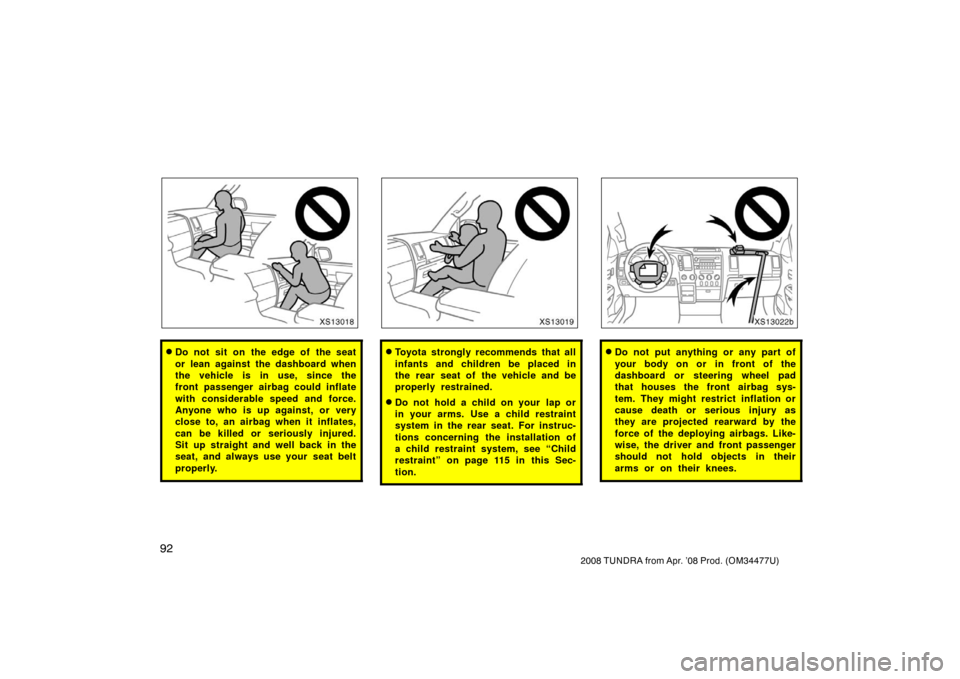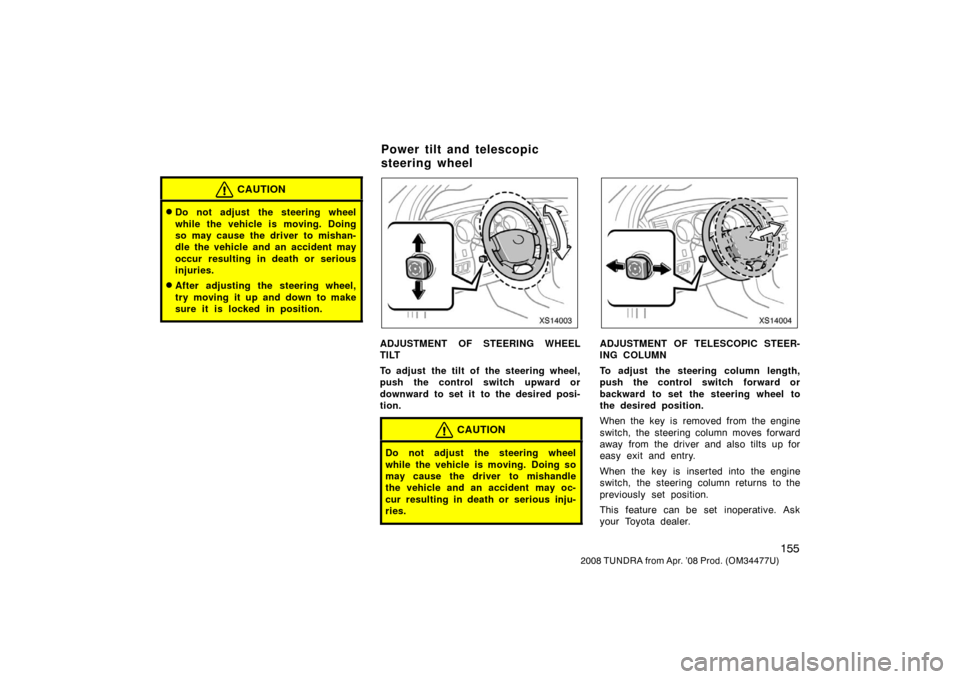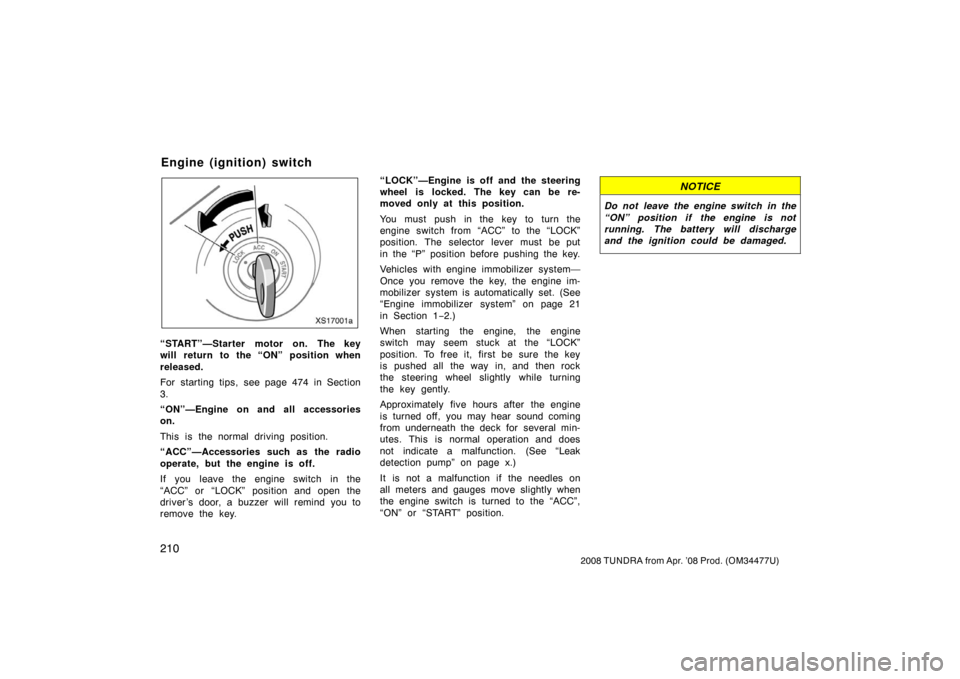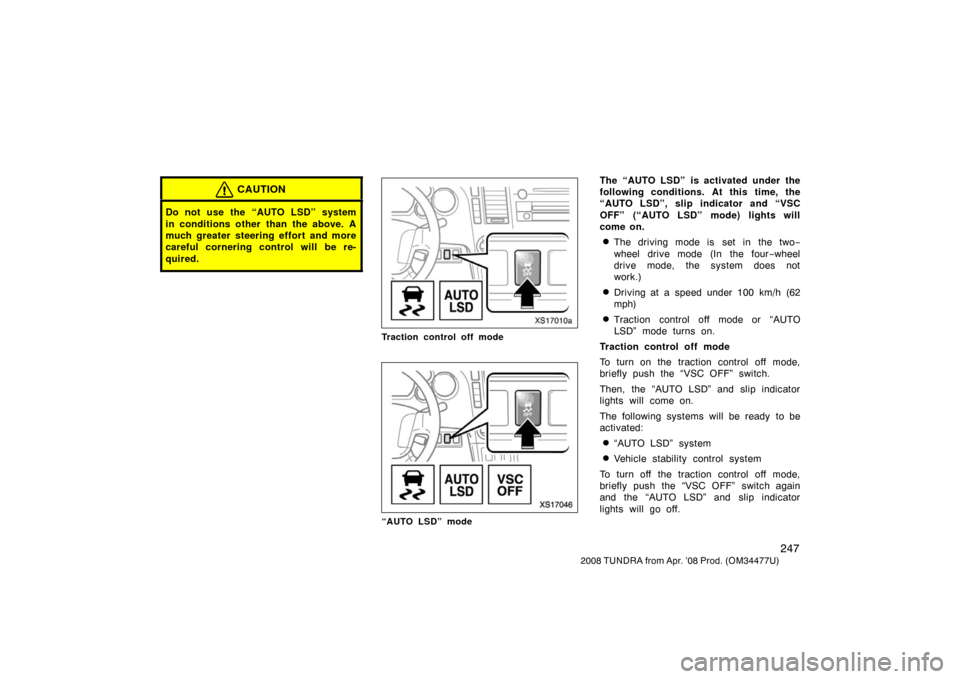Page 102 of 621

92
2008 TUNDRA from Apr. ’08 Prod. (OM 34477U)
XS13018
�Do not sit on the edge of the seat
or lean against the dashboard when
the vehicle is in use, since the
front passenger airbag could inflate
with considerable speed and force.
Anyone who is up against, or very
close to, an airbag when it inflates,
can be killed or seriously injured.
Sit up straight and well back in the
seat, and always use your seat belt
properly.
XS13019
�Toyota strongly recommends that all
infants and children be placed in
the rear seat of the vehicle and be
properly restrained.
�Do not hold a child on your lap or
in your arms. Use a child restraint
system in the rear seat. For instruc-
tions concerning the installation of
a child restraint system, see “Child
restraint” on page 115 in this Sec-
tion.
XS13022b
�Do not put anything or any part of
your body on or in front of the
dashboard or steering wheel pad
that houses the front airbag sys-
tem. They might restrict inflation or
cause death or serious injury as
they are projected rearward by the
force of the deploying airbags. Like-
wise, the driver and front passenger
should not hold objects in their
arms or on their knees.
Page 103 of 621

93
2008 TUNDRA from Apr. ’08 Prod. (OM 34477U)
�Do not modify or remove any wir-
ing. Do not modify, remove, strike
or open any components such as
the steering wheel pad, steering
wheel, column cover, dashboard
near the front passenger airbag,
front passenger airbag cover, front
passenger airbag or airbag sensor
assembly. Doing so may prevent the
front airbag system from activating
correctly, cause sudden activation
of the system or disable the sys-
tem, which could result in death or
serious injury.
�Do not modify or change the sus-
pension system. Such changes may
cause the driver airbag, front pas-
senger airbag, seat belt pretension-
ers and curtain shield airbags to
inflate accidentally, which could re-
sult in death or serious injury.
�Do not use tires or wheels other
than the manufacturer ’s recom-
mended size. Such a use may cause
the driver airbag, front passenger
airbag, seat belt pretensioners and
curtain shield airbags to inflate ac-
cidentally, which could result in
death or serious injury. For details,
see “Checking and replacing tires”
on page 556 in Section 7�2.
Failure to follow these instructions
can result in death or serious injury.
Consult your Toyota dealer about any
repair and modification.
If you wish to modify your vehicle for
a person with a physical disability,
consult your Toyota dealer. It may
dangerously interfere with the SRS
front airbags operation.NOTICE
Do not perform any of the following
changes without consulting your
Toyota dealer. Such changes can
interfere with proper operation of the
SRS front airbag system in some
cases.
� Installation of electronic devices
such as a mobile two�way radio,
cassette tape player or compact
disc player
� Modification of the suspension sys-
tem
� Modification of the front end struc-
ture
� Attachment of a grille guard (bull
bar, kangaroo bar, etc.), snowplow,
winches or any other equipment to
the front end
� Repairs made on or near the front
fenders, front end structure, con-
sole, steering column, steering
wheel, front passenger ’s seat or
dashboard near the front passenger
airbag
Page 104 of 621

94
2008 TUNDRA from Apr. ’08 Prod. (OM 34477U)
XS13135a
This indicator comes on when the en-
gine switch is turned to the “ON” posi-
tion. It goes off after about 6 seconds.
This means the SRS front airbags are
operating properly.
This warning light system monitors the
airbag sensor assembly, front airbag
sensors, side and curtain shield airbag
sensors, curtain shield airbag sensors,
driver ’s seat position sensor, driver ’s seat
belt buckle switch, front passenger
occupant classification system
∗, passenger
airbag on −off indicator light, seat belt
pretensioner assemblies, inflators, “RSCA
OFF” indicator light, interconnecting wiring
and power sources. (For details, see
“Service reminder indicators and warning
buzzers” on page 197 in Section 1 −6.)
∗: The front passenger occupant classifica-
tion system includes the front passenger
occupant classification ECU, load sensor
and front passenger ’s seat belt buckle
switch.
If either of the following conditions occurs,
this indicates a malfunction of the airbags
or seat belt pretensioners. Contact your
Toyota dealer as soon as possible.
�The light does not come on when the
engine switch is turned to the “ON”
position or remains on for more than
6 seconds.
�The light comes on while driving.
The SRS warning light will come on and
passenger airbag on −off indicator light will
indicate “OFF” if there is a malfunction in
the front passenger occupant classification
system.
XS13133a
In the following cases, contact your Toyota
dealer as soon as possible:
�The SRS front airbags have been in-
flated.
�The front of the vehicle (shaded in the
illustration) was involved in an accident
that was not severe enough to cause
the SRS front airbags to inflate.
�The pad section of the steering wheel
or front passenger airbag cover
(shaded in the illustration) is scratched,
cracked, or otherwise damaged.
Page 163 of 621
153
2008 TUNDRA from Apr. ’08 Prod. (OM 34477U)
OPERATION OF INSTRUMENTS AND
CONTROLS
Steering wheel and Mirrors
Tilt steering wheel 154
. . . . . . . . . . . . . . . . . . . . . . . . . . . . . . . . . . . . .\
. . . . .
Tilt and telescopic steering wheel 154
. . . . . . . . . . . . . . . . . . . . . . . . . . . . .
Power tilt and telescopic steering wheel 155
. . . . . . . . . . . . . . . . . . . . . . .
Outside rear view mirrors 156
. . . . . . . . . . . . . . . . . . . . . . . . . . . . . . . . . . . . \
Anti −glare inside rear view mirror 159
. . . . . . . . . . . . . . . . . . . . . . . . . . . . .
Auto anti −glare inside rear view mirror 160
. . . . . . . . . . . . . . . . . . . . . . . .
Sun visors 161
. . . . . . . . . . . . . . . . . . . . . . . . . . . . . . . . . . . . \
. . . . . . . . . . . . .
Vanity mirrors 161
. . . . . . . . . . . . . . . . . . . . . . . . . . . . . . . . . . . . \
. . . . . . . . . .
SECTION 1� 4
Page 164 of 621
154
2008 TUNDRA from Apr. ’08 Prod. (OM 34477U)
XS14002
To change the steering wheel angle,
hold the steering wheel, push down the
lock release lever, tilt the steering
wheel to the desired angle and return
the lever to its original position.
CAUTION
�Do not adjust the steering wheel
while the vehicle is moving. Doing
so may cause the driver to mishan-
dle the vehicle and an accident may
occur resulting in death or serious
injuries.
�After adjusting the steering wheel,
try moving it up and down to make
sure it is locked in position.
XS14001
To adjust the steering wheel position,
push down the lock release lever. Then
tilt the steering wheel to the desired
angle, push or pull it to the desired
steering column length and pull up the
lock release lever.
Tilt steering wheel Tilt and telescopic steering
wheel
Page 165 of 621

155
2008 TUNDRA from Apr. ’08 Prod. (OM 34477U)
CAUTION
�Do not adjust the steering wheel
while the vehicle is moving. Doing
so may cause the driver to mishan-
dle the vehicle and an accident may
occur resulting in death or serious
injuries.
�After adjusting the steering wheel,
try moving it up and down to make
sure it is locked in position.
XS14003
ADJUSTMENT OF STEERING WHEEL
TILT
To adjust the tilt of the steering wheel,
push the control switch upward or
downward to set it to the desired posi-
tion.
CAUTION
Do not adjust the steering wheel
while the vehicle is moving. Doing so
may cause the driver to mishandle
the vehicle and an accident may oc-
cur resulting in death or serious inju-
ries.
XS14004
ADJUSTMENT OF TELESCOPIC STEER-
ING COLUMN
To adjust the steering column length,
push the control switch forward or
backward to set the steering wheel to
the desired position.
When the key is removed from the engine
switch, the steering column moves forward
away from the driver and also tilts up for
easy exit and entry.
When the key is inserted into the engine
switch, the steering column returns to the
previously set position.
This feature can be set inoperative. Ask
your Toyota dealer.
Power tilt and telescopic
steering wheel
Page 220 of 621

210
2008 TUNDRA from Apr. ’08 Prod. (OM 34477U)
XS17001a
“START”—Starter motor on. The key
will return to the “ON” position when
released.
For starting tips, see page 474 in Section
3.
“ON”—Engine on and all accessories
on.
This is the normal driving position.
“ACC”—Accessories such as the radio
operate, but the engine is off.
If you leave the engine switch in the
“ACC” or “LOCK” position and open the
driver ’s door, a buzzer will remind you to
remove the key. “LOCK”—Engine is off and the steering
wheel is locked. The key can be re-
moved only at this position.
You must push in the key to turn the
engine switch from “ACC” to the “LOCK”
position. The selector lever must be put
in the “P” position before pushing the key.
Vehicles with engine immobilizer system—
Once you remove the key, the engine im-
mobilizer system is automatically set. (See
“Engine immobilizer system” on page 21
in Section 1−
2.)
When starting the engine, the engine
switch may seem stuck at the “LOCK”
position. To free it, first be sure the key
is pushed all the way in, and then rock
the steering wheel slightly while turning
the key gently.
Approximately five hours after the engine
is turned off, you may hear sound coming
from underneath the deck for several min-
utes. This is normal operation and does
not indicate a malfunction. (See “Leak
detection pump” on page x.)
It is not a malfunction if the needles on
all meters and gauges move slightly when
the engine switch is turned to the “ACC”,
“ON” or “START” position.
NOTICE
Do not leave the engine switch in the
“ON” position if the engine is not
running. The battery will discharge
and the ignition could be damaged.
Engine (ignition) switch
Page 257 of 621

247
2008 TUNDRA from Apr. ’08 Prod. (OM 34477U)
CAUTION
Do not use the “AUTO LSD” system
in conditions other than the above. A
much greater steering effort and more
careful cornering control will be re-
quired.
XS17010a
Traction control off mode
XS17046
“AUTO LSD” mode
The “AUTO LSD” is activated under the
following conditions. At this time, the
“AUTO LSD”, slip indicator and “VSC
OFF” (“AUTO LSD” mode) lights will
come on.
�The driving mode is set in the two −
wheel drive mode (In the four −wheel
drive mode, the system does not
work.)
�Driving at a speed under 100 km/h (62
mph)
�Traction control off mode or “AUTO
LSD” mode turns on.
Traction control off mode
To turn on the traction control off mode,
briefly push the “VSC OFF” switch.
Then, the “AUTO LSD” and slip indicator
lights will come on.
The following systems will be ready to be
activated:
�“AUTO LSD” system
�Vehicle stability control system
To turn off the traction control off mode,
briefly push the “VSC OFF” switch again
and the “AUTO LSD” and slip indicator
lights will go off.